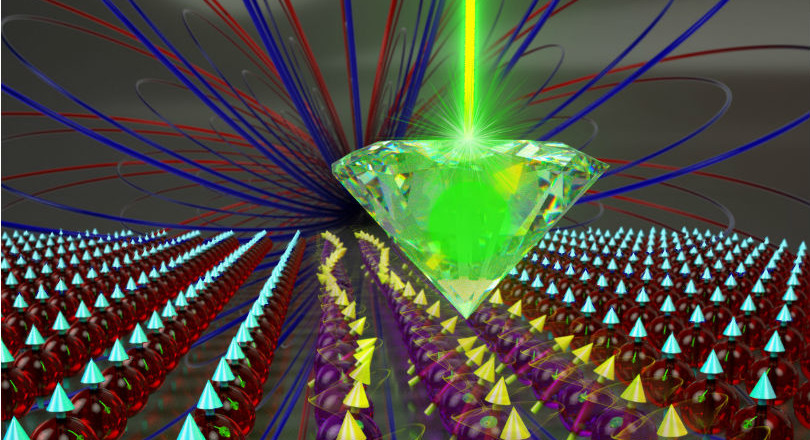Sensing electrical current with diamond sensors
Observing the invisible. Measuring what has never been measured before. These are just a few subjects related to the day-to-day work life of Dr. Toeno van der Sar (Quantum Nanoscience). In his research group, he uses extraordinarily small magnets to probe the boundaries of physics.
Until recently, it was impossible to measure extremely weak magnetic fields generated by electrical current. The discovery of a sensor as small as an atom, however, has changed the game. The name of this sensor? The NV-centre. With the NV-centre, weak magnetic fields generated by electrical current can be measured. This feature could, for example, contribute to the development of better computer chips.
Nature’s mistake
The NV-centre, that can be found in diamond, is the result of a small mistake made by nature. The structure of a pure diamond consists of a grid that exclusively contains carbon atoms. Van der Sar: “NV stands for nitrogen-vacancy and it is a defect in the structure of diamond. NV-centres are present in nature, but you can also make them yourself by bombarding a diamond with nitrogen atoms. This process not only results in the presence of nitrogen in the diamond, but also causes empty spaces to form in the diamond grid. When you heat the bombarded diamond up to a thousand degrees, the empty grid spaces will move until they meet a nitrogen atom.” With this encounter, the NV-centre is born.
The NV-centre is a sort of extremely tiny magnet. “When you put a magnet in a magnetic field, it wants to align in a certain direction with that magnetic field. Aligning in the opposite direction is not preferred, since this will cost a lot of energy”, explains Van der Sar. “The stronger the magnetic field, the larger the energy cost.” Since the NV-centre is so small, it is sensitive to very weak magnetic fields, allowing them to be measured.
A sea of small magnets
Whereas the NV-centre consists of only one small magnet, a magnetic material, such as a piece of iron, can be seen as a collection of billions of small magnets. Van der Sar: “All these small magnets together move through the material in a certain wave pattern called a spin wave. You can locally induce a spin wave that will consequently propagate through the material.” It is very hard to measure these spin waves, but the NV-centre makes this possible. Recently, the Van der Sar lab succeeded in observing spin waves in magnets. But what can you use them for? “Contrary to electrical current, spin waves produce little heat”, explains Van der Sar. “Therefore, we could use them as an alternative way of information transport on computer chips, for instance. Measuring spin waves is essential for the development of this new way of information transport.”
A honeycomb of carbon
The potential applications of the NV-centre are many. The tiny sensor could, for example, be used to test the quality of the material graphene. The structure of graphene is a honeycomb of carbon atoms. Just as in in diamond, the structure of graphene can contain minor errors. “One way to assess the quality of graphene is by determining how homogeneous the electrical current is that you can send through such a material”, says Van der Sar. With an NV-centre, you can measure the weak magnetic fields generated by this current. Defects in the structure of graphene can thus be detected. This could help optimise the quality of graphene – a material that could for example be used to make even better LED TVs.
Magnetic glasses
In the future, the NV-centre could also be used in microscopy. “An NV-centre can be compared with an extremely sensitive MRI scanner, with which you can depict magnetic fields on the nanoscale”, says Van der Sar. This principle could be applied to the development of a new microscope. Unlike regular light microscopes, this microscope would not look at the light being scattered by the material, but at the magnetic fields that it produces locally. “It is like putting on a pair of magnetism-observing glasses.”
Such a microscope for magnetism can, for instance, be used to observe electrical current in computer chips. This could be a good way to detect defects. Van der Sar: “If chips contain defects, there are certain hotspots which are hard to find, except when you can see the current. If you can see the current, you can also determine where a lot of that current is flowing. Thus, you can identify small holes in the structure that are normally hard to find.” It is like using a bucket of water to find a puncture in a bicycle tyre, where air flowing through the little hole creates small air bubbles. With the NV-centre, we could detect the “air bubbles” in a computer chip.
Canal water
Van der Sar is looking forward to the future and to learning even more using the NV-centre as a tool. “My motivation to work on this research are the unexpected discoveries you make when you look at a physical phenomenon in a new way. In my case, these are magnetic fields on the nanoscale. Sometimes, I just feel the way Antonie van Leeuwenhoek must have felt when he put water from the canals of Delft under his microscope. He had no clue what he would find there and ended up discovering a whole new world. That is one of my biggest motivations for this research: to work with a technique that enables us to see new things.“
Did you know...
that the Danish physicist Hans Christian Ørsted already showed in the 19th century that electrical current generates a magnetic field? He did this by holding a compass needle close to an electrical wire. Every time he put the current on or off, he noticed that the compass needle moved a little. With this observation, Ørsted confirmed the relationship between electricity and magnetism.
Selected Scientific Works of Hans Christian Ørsted

